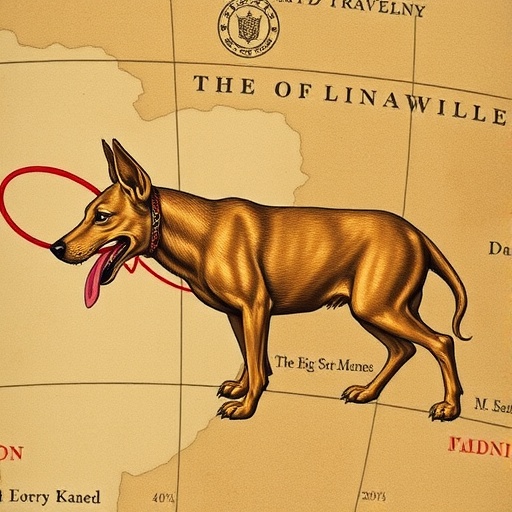New Genomic Insights Reveal Dogs and Humans Moved in Tandem Across Holocene Eurasia
For millennia, the bond between humans and dogs has been a defining story in the annals of evolution and culture. A groundbreaking study recently published in Science now provides compelling genomic evidence that dogs did not merely coexist with early human populations but actively accompanied them as they migrated and settled across vast regions of Holocene Eurasia. This research unravels an intricate narrative of codispersal, cultural interchanges, and ancient partnerships that helped forge the biological and social landscapes of Eastern Eurasia.
The study, spearheaded by Shao-Jie Zhang and colleagues, undertook comprehensive sequencing of 17 ancient dog genomes ranging from approximately 9,700 to 870 years before present. These samples were extracted from archaeological sites spread over Siberia, the Central Eurasian Steppe, and northwest China—regions noted for dynamic shifts in human ancestry and cultures during the Holocene epoch. By integrating these data with 57 previously published ancient dog genomes, alongside 160 modern dog genomes and 18 ancient human genomes, the researchers erected a robust comparative framework to explore how early canine lineages paralleled human kinship and migration patterns.
Historically, dog domestication and dispersal have been among the most enigmatic facets of human prehistory. While archaeological evidence suggested domestic dogs appeared over 11,000 years ago, the full scope and complexity of their geographic and genetic dispersals remained unclear. This study reveals that major dog lineages diverged thousands of years earlier, predating some human migrations, and strongly suggests that dogs were not passive adoptees but active participants in human colonization across Europe, Asia, and the Arctic.
Utilizing advanced genomic sequencing technologies and population genomics analyses, the team uncovered that as hunter-gatherer communities, farming groups, and pastoralists ventured across continental expanses, their canine companions frequently accompanied them. This pattern of codispersal was particularly evident along the immense Eurasian Steppe, a pivotal corridor for human migration and interaction. The genetic signatures embedded in these canine genomes mirror the cultural and ancestral shifts observed in human genomes from the same locales and time periods, underscoring a profound intertwined journey.
What adds an unexpected layer of complexity is the observation that certain dog lineages do not neatly align with the genetic histories of their human hosts. Such mismatches illuminate episodes of dog exchange between disparate populations—communities with distinct cultural and genetic backgrounds actively traded or shared dogs, emphasizing the role of these animals as social connectors and cultural commodities. The Arctic-lineage dogs serve as a prime example; their presence across hunter-gatherer groups of diverse ancestries indicates a dynamic exchange system where dogs were valued assets transcending ethnic boundaries.
The implications of these findings ripple beyond anthropology and archaeology, touching ethology, genetics, and evolutionary biology. Dogs’ role in facilitating human adaptation to new environments, from frigid Arctic tundras to temperate steppe ecosystems, now gains genetic corroboration. The study suggests that dogs may have enhanced human survival strategies by contributing to hunting, mobility, and social cohesion, thereby influencing migration success.
Further, the complex interplay of dog and human genetic lineages reveals insights into social networks and trade systems of prehistoric societies. It proposes that dogs served as cultural vectors, facilitating exchange not only of goods and genes but of ideas and practices, acting as living bridges between once isolated groups. Such dynamics hint at an early form of biocultural globalization where domesticated animals were integral components.
Technological advances in ancient DNA extraction and genome-wide analyses empowered this research to transcend previous limitations that often restricted studies to fragments of mitochondrial DNA or sparse archaeological records. By sequencing entire genomes from multiple time points and geographic regions, the researchers reconstructed a high-resolution timeline of canine evolution deeply intertwined with human history.
This study also elevates the significance of interdisciplinary collaborations—melding archaeology, genomics, paleontology, and ethnography—to form holistic narratives about our shared pasts. It encourages future explorations into how co-domestication processes shape species and how human-animal relationships drive evolutionary trajectories spanning thousands of years.
In essence, the genomic landscape painted by Zhang et al. transforms our understanding of dogs from mere companion animals to active agents in human prehistory. Their movements, genetic adaptations, and exchanges parallel human endeavors, reflecting a mutualism that transcended subsistence to affect cultural evolution and identity formation across continents.
As this research continues to inspire deeper investigations, it challenges scholars to rethink the dichotomy between human and animal histories. The story of the dog, now more than ever, appears inseparable from the saga of humanity’s rise, migration, and transformation across the vast reaches of Eurasia during the Holocene.
Subject of Research: Genomic analysis of ancient dog lineages to understand their codispersal with human populations across Eastern Eurasia during the Holocene epoch.
Article Title: Genomic evidence for the Holocene codispersal of dogs and humans across Eastern Eurasia
News Publication Date: 13-Nov-2025
Web References:
10.1126/science.adu2836
Keywords: dog domestication, ancient DNA, Holocene migrations, human-dog codispersal, Eurasian Steppe, genomic sequencing, prehistoric trade, Arctic-lineage dogs, population genetics, archaeological genomics




